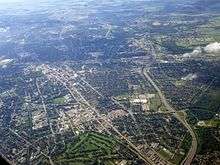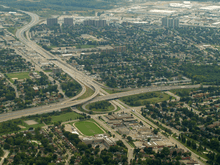Conestoga Parkway
| |
|---|---|
| Conestoga Expressway | |
| Route information | |
| Length: | 31.1 km[1] (19.3 mi) |
| Existed: | 1969 – present |
| Major junctions | |
| West end: |
|
|
| |
| To: | 350 metres (383 yd) north of King Street North interchange |
| Location | |
| Major cities: | Kitchener, Waterloo |
| Highway system | |
| Roads in Ontario | |
The Conestoga Parkway is a freeway in the Regional Municipality of Waterloo, in the Canadian province of Ontario. It runs northeast/southwest through the cities of Kitchener and Waterloo, and is connected to Highway 401 via the Highway 8 Freeport Diversion and King Street East. The name "Conestoga Parkway" is not a formal designation, but rather a local name applied to the divided expressway portions of Highway 7, Highway 8 and Highway 85 through Kitchener and Waterloo. When the parkway opened in the late 1960s there were a few large green and white signs reading "Conestoga Parkway" with a picture of a Conestoga wagon on them located along the parkway. By the 1990s after several sections of the parkway had undergone reconstruction and expansion, these signs had been removed but many maps still show this as the name of the freeway. Most residents of Kitchener and Waterloo refer to the parkway as "The Expressway". By contrast, the portion of Highway 8 which departs from the parkway at King Street East in Kitchener and runs to Highway 401 is often referred to as "The Highway 8 Expressway" by local residents.
Route description

The multiplex of Highway 7 and Highway 8 enters the city of Kitchener as a controlled-access freeway from the west; it takes on the name Conestoga Parkway at the Trussler Road exit at the western edge of the city. The Parkway (and the multiplex) continues east until Highway 8 (the Freeport Diversion) branches off toward the southeast via an interchange. At this point, the Conestoga Parkway turns northward and becomes Highway 7.
At the Victoria Street exit, the Parkway sheds the Highway 7 designation and becomes Highway 85 (which had been known as Highway 86 until May 1, 2003). It continues through the city of Waterloo towards St. Jacobs, where the freeway alignment ends and becomes Regional Road 85, or Arthur Street South.
Note that the Parkway is merely a controlled-access portion of the three numbered highways, all of which continue for some distance beyond the freeway referred to as the Conestoga Parkway. Thus, the freeway has the distinction of being one of the few Ontario-maintained freeways not numbered according to the 400-Series Highway network, even though it is busier and wider than many rural 400-series highways, because the freeway upgrade has joined together only parts of existing routes. In comparison, the 400-series highways are intended to be full freeways for their entire length.
The speed limit on the Conestoga Parkway is 90 km/h (55 mph). From its completion in the late 1960s its speed limit was 100 km/h, but the limit was lowered in the late 1990s due to collisions across the grass median (since replaced with Ontario tall-wall). Highway 7/8 between Courtland Avenue and Fischer-Hallman Road has an abnormally narrow median, and overpasses are single structures with simple curbs as median dividers instead of the usual Jersey barrier or Ontario tall-wall. The portion of Highway 7/8 (from Trussler Road to Wilmot Centre Road/Foundry Street) which was converted into a freeway in the 1990s does not have this deficiency, nor do the portions of the Parkway signed as Highways 7 and 85.
History


The parkway is one of the busiest roads in the region. It was completed as a four-lane freeway in the late 1960s, with the exception of the short eight-lane collector-express system serving Highway 7/Victoria Street and Wellington Street. Mainline traffic on Highway 8 could continue under the Conestoga, where the route defaults to King Street, to enter downtown Kitchener. The Conestoga east/north of this junction serves as a bypass of King Street.
At the time, the Conestoga Parkway and Highway 8 Freeport Diversion freeways were isolated from the 400-series highway network, as the Freeport Diversion ended at an at-grade Y-junction with King Street East. Traffic from the Freeport Diversion was treated as the mainline traffic at this interchange and King East continued to a cloverleaf interchange with Highway 401.
A direct freeway connection between Highway 401 and the Conestoga was made possible when a new bypass (secretly designated as Highway 7187, and signed with Highway 8 and Highway 401 trailblazers, but later made part of Highway 8) was opened in 1987; it featured a Y-junction with Highway 401 to serve traffic east of that junction. The cloverleaf interchange with the existing Highway 8 had several ramps realigned, and it continues to serve traffic from eastbound Highway 401. There remains no direct freeway connection to Highway 8 from Highway 401 westbound. Drivers wishing to travel from Kitchener-Waterloo onto Highway 401 Westbound (London) are required to divert onto "old Highway 8", through several sets of traffic lights causing considerable traffic congestion.
In 1993, a four-lane extension to Baden was opened, linking up with an existing undivided four-lane expressway at New Hamburg.

Since the late 1990s, the Conestoga has undergone extensive reconstruction between Courtland Avenue and Lancaster Street, with the addition of an Ontario "tall-wall" concrete median barrier and high-mast lighting replacing the conventional mercury truss lights. The widening project resulted that stretch of the Parkway being expanded to at least six lanes by using the grass median, and eight lanes between Highway 8 and a location midway between Ottawa and Frederick Streets (north of that location was already eight lanes) by using the right-of-way afforded by the shoulders. In 2004, extensive improvements were completed around the former obsolete and bottlenecked "half-cloverleaf" junction with the freeway section of Highway 8, that links it to the Highway 401. This included a new flyover semi-directional ramp from Conestoga westbound to Highway 8 eastbound, while the ramp in the opposite direction was realigned to allow it to carry two lanes of traffic at a higher speed.
An observation which may seem odd for those new to the highway is the stark difference in the congested, inefficient exit for Highway 7/Victoria Street, when compared with the high-capacity but underused Wellington Street exit just north of it. Both exits are served by a collector-express system. This is due to the expectation that Highway 7 would be redirected as a controlled-access highway and attached to the existing Wellington Street interchange; these plans have languished for over 30 years and are still in the planning stages.
Future
Opposition has arisen due to the new alignment of Highway 7 passing through environmentally sensitive lands. The new Highway 7 freeway proposal, linking up the Conestoga in Kitchener and the Hanlon Parkway in Guelph, bypasses the existing Highway 7/Victoria Street. The plans also call for a complex 4-level interchange with the Conestoga Parkway and Wellington Street, a rarity outside of the Greater Toronto Area. Its $25 million cost represents a quarter of the $100 million budget for the total project, with the high cost partly due to the difficulty in land acquisition to accommodate the flyover ramps.
Starting in 2013, the section running from just east of Courtland Avenue to just west of Fischer-Hallman Road has undergone widening and upgrading. Replacement of the Westmount Road overpass and a rebuild of the Fischer-Hallman interchange happened in the first year; the remainder is set to be completed by 2015.
In addition to the proposed Highway 7 freeway between Kitchener and Guelph, the Ministry of Transportation has long term plans to widen and reroute Highway 7/8 westward to Stratford. How this will affect the village of Shakespeare, which the open highway currently bisects, is a particular sticking point.

Exit list
The following table lists the major junctions along Conestoga Parkway, as noted by the Ministry of Transportation of Ontario. The entire route is located in the Regional Municipality of Waterloo. All exits are unnumbered.
| Location | km | mi | Destinations | Notes | |
|---|---|---|---|---|---|
| Wilmot Township | 0.0 | 0.0 | Waterloo Regional Road 51, Foundry St., Wilmot Centre Rd. | Parclo AB2 | |
| 5.1 | 3.2 | Waterloo Regional Road 12, Notre Dame Dr., Queen St. | Parclo A2 | ||
| Kitchener | 8.9 | 5.5 | Waterloo Regional Road 70, Trussler Rd., Ira Needles Blvd. | Parclo A2 | |
| 12.0 | 7.5 | Waterloo Regional Road 58, Fischer-Hallman Rd. | Parclo AB2 | ||
| 14.4 | 8.9 | Waterloo Regional Road 4, Ottawa St. S. Waterloo Regional Road 28, Homer Watson Blvd. (one loop ramp) | Parclo (half, only one loop ramp) | ||
| Waterloo Regional Road 28, Homer Watson Blvd. | Diamond (half) | ||||
| 15.7 | 9.8 | Waterloo Regional Road 53, Courtland Ave. E. | Parclo AB2 | ||
| 17.1 | 10.6 | High-speed trumpet with King Street access to and from southern Highway 8 | |||
| 18.4 | 11.4 | Waterloo Regional Road 4, Ottawa St. N. | Parclo A2 | ||
| 20.3 | 12.6 | Highway 7, Waterloo Regional Road 61, Bruce St. Highway 7, Waterloo Regional Road 55, Victoria St. N. | Stretched Diamond (with Bruce St.) | ||
| Highway 7, Waterloo Regional Road 62, Edna St. Highway 7, Waterloo Regional Road 55, Victoria St. N. | Stretched Diamond (with Edna St.) | ||||
| 20.6 | 12.8 | Wellington St. N. Riverbend Dr. Shirley Ave. | |||
| Waterloo | 22.1 | 13.7 | Waterloo Region Route 29 South, Lancaster St. W. | Diamond (quarter) | |
| 23.0 | 14.3 | Waterloo Regional Road 9, Bridgeport Rd. E. | Parclo AB3 | ||
| 24.5 | 15.2 | Waterloo Regional Road 57, University Ave. E. | Parclo AB4 | ||
| 26.9 | 16.7 | Waterloo Regional Road 15, King St. N. | Parclo A3 | ||
| 28.2 | 17.5 | Waterloo Regional Road 50, Northfield Dr. W. | Parclo B2 | ||
| Woolwich Township | 29.8 | 18.5 | Waterloo Regional Road 15, King St. N. | Parclo A2 | |
| 30.1 | 18.7 | ||||
| 1.000 mi = 1.609 km; 1.000 km = 0.621 mi | |||||
See also
External links
References
- ↑ Ministry of Transportation of Ontario (2007). "Annual Average Daily Traffic (AADT) counts". Retrieved September 17, 2011.